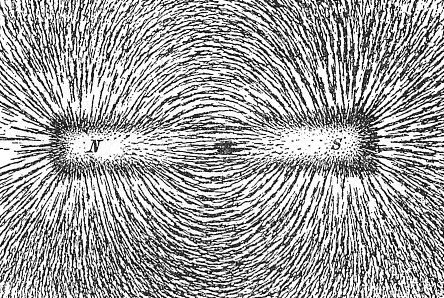Lea el texto y realice las actividades.
What are magnetic fields?
Most of us have some familiarity with everyday magnetic objects and recognize that there can be forces between them. We understand that magnets have two poles and that depending on the orientation of two magnets there can be attraction (opposite poles) or repulsion (similar poles). We recognize that there is some region extending around a magnet where this happens. The magnetic field describes this region.
- The magnetic field is described mathematically as a vector field. This vector field can be plotted directly as a set of many vectors drawn on a grid. Each vector points in the direction that a compass would point and has length dependent on the strength of the magnetic force. Arranging many small compasses in a grid pattern and placing the grid in a magnetic field illustrates this technique. The only difference here is that a compass doesn't indicate the strength of a field.
- An alternative way to represent the information contained within a vector field is with the use of field lines. Here we dispense with the grid pattern and connect the vectors with smooth lines. We can draw as many lines as we want.
The field-line description has some useful properties:
- Magnetic field lines never cross.
- Magnetic field lines naturally bunch together in regions where the magnetic field is the strongest. This means that the density of field lines indicates the strength of the field.
- Magnetic field lines don't start or stop anywhere, they always make closed loops and will continue inside a magnetic material (though sometimes they are not drawn this way).
We require a way to indicate the direction of the field. This is usually done by drawing arrowheads along the lines. Sometimes arrowheads are not drawn and the direction must be indicated in some other way. For historical reasons the convention is to label one region 'north' and another 'south' and draw field lines only from these 'poles'. The field is assumed to follow the lines from north to south. 'N' and 'S' labels are usually placed on the ends of a magnetic field source, although strictly this is arbitrary and there is nothing special about these locations.
Field lines can be visualized quite easily in the real world. This is commonly done with iron filings dropped on a surface near something magnetic. Each filing behaves like a tiny magnet with a north and south pole. The filings naturally separate from each other because similar poles repel each other. The result is a pattern that resembles field lines. While the general pattern will always be the same, the exact position and density of lines of filings depends on how the filings happened to fall, their size and magnetic properties.
How do we measure magnetic fields?
ACTIVIDADES
CUESTIONARIO
1. ¿Con qué estamos familiarizados según este artículo?
2. ¿De qué depende la atracción de los imanes?
3. ¿Qué describe la región alrededor de un imán?
4. ¿Cómo se describe el campo magnético matemáticamente?
5. ¿Cómo se traza este campo?
6. ¿A dónde apunta cada vector?
7. ¿Qué ilustra la técnica de disposición de los vectores?
8. ¿Qué se considera cuando se mide una cantidad vectorial?
9 ¿Cómo se mide la velocidad?
10. ¿Qué se descubrió en 1988?
11. ¿En dónde se aplica este descubrimiento?
1. An alternative way to represent the information ...
2. Magnetic field lines naturally ...
3. Sometimes arrowheads ...
4. The field is assumed to follow the lines ...
5. While the general pattern ...




No hay comentarios:
Publicar un comentario
Respuestas: